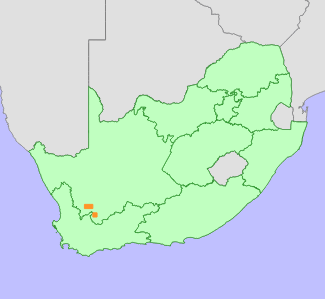|
Scientific Name | Polhillia involucrata (Thunb.) B.-E.van Wyk & A.L.Schutte |
Higher Classification | Dicotyledons |
Family | FABACEAE |
Synonyms | Argyrolobium involucratum (Thunb.) Harv., Genista involucrata (Thunb.) Briq., Melolobium involucratum (Thunb.) C.H.Stirt., Psoralea involucrata Thunb. |
National Status |
Status and Criteria | Endangered B1ab(iii,v)+2ab(iii,v) |
Assessment Date | 2019/11/10 |
Assessor(s) | D. Raimondo & A.L. Schutte-Vlok |
Justification | Polhillia involucrata is a range-restricted Roggeveld endemic, with an extent of occurrence (EOO) of 303 km² and area of occupancy (AOO) of 20 km². This species has been recorded from three subpopulations that occur at three locations. Habitat loss in the past has occurred due to crop cultivation and livestock grazing. Being highly palatable, this species continues to experience ongoing decline as a result of overgrazing. Ongoing aridification of the area due to climate change is likely to cause further decline. It therefore qualifies as Endangered under criterion B. |
Distribution |
Endemism | South African endemic |
Provincial distribution | Northern Cape |
Range | This species is endemic to South Africa, and is found in the Roggeveld Escarpment. |
Habitat and Ecology |
Major system | Terrestrial |
Major habitats | Roggeveld Karoo, Roggeveld Shale Renosterveld |
Description | It occurs in mountain renosterveld on well-drained, sandy loams. |
Threats |
| Polhillia involucrata is a highly palatable species that is threatened by overgrazing. Remaining subpopulations are found in road reserves (areas that are seldom or never grazed). This species has also lost habitat to crop cultivation in the past. Furthermore its habitat is being degraded by increasing frequency and duration of drought. |
Population |
Plants are extremely localized, and largely confined to road verges. It is very conspicuous when in flower and yet no more than three subpopulations have been found to date.
|
Population trend | Decreasing |
Assessment History |
Taxon assessed |
Status and Criteria |
Citation/Red List version | | Polhillia involucrata (Thunb.) B.-E.van Wyk & A.L.Schutte | Rare | Raimondo et al. (2009) | | Polhillia involucrata (Thunb.) B.-E.van Wyk & A.L.Schutte | Rare | Hilton-Taylor (1996) | |
Bibliography |
Dahlgren, R. and Goldblatt, P. 1982. A note on the rediscovery of Argyrolobium involucratum (Thunb.) Harv. and the generic borderline between Argyrolobuim and Melolobium (Fabaceae - Crotalarieae). Annals of the Missouri Botanical Garden 68(4):558-561.
Hilton-Taylor, C. 1996. Red data list of southern African plants. Strelitzia 4. South African National Botanical Institute, Pretoria.
Raimondo, D., von Staden, L., Foden, W., Victor, J.E., Helme, N.A., Turner, R.C., Kamundi, D.A. and Manyama, P.A. 2009. Red List of South African Plants. Strelitzia 25. South African National Biodiversity Institute, Pretoria.
Snijman, D.A. 2013. Plants of the Greater Cape Floristic Region 2: The extra Cape flora. Strelitzia 30. South African National Biodiversity Institute, Pretoria.
Stirton, C.H. 1986. Melolobium involucratum (Fabaceae), a new combination for South Africa. South African Journal of Botany 52(4):354-356.
Van Wyk, B.-E. and Schutte, A.L. 1989. Crotalarieae and Argyrolobium. Kew Bulletin 44(3):420-421.
|
Citation |
| Raimondo, D. & Schutte-Vlok, A.L. 2019. Polhillia involucrata (Thunb.) B.-E.van Wyk & A.L.Schutte. National Assessment: Red List of South African Plants version 2024.1. Accessed on 2025/11/16 |
 Comment on this assessment
Comment on this assessment


